Human Resource Management: Introduction, Practices, and Analysis
VerifiedAdded on 2020/01/28
|10
|4236
|73
Report
AI Summary
This report provides a comprehensive introduction to Human Resource Management (HRM). It explores the purpose and functions of HRM, focusing on workforce planning and resourcing, and discusses the strengths and weaknesses of different recruitment and selection methods. The report further examines the benefits of various HR practices for both employers and employees, and evaluates their effectiveness in terms of organizational profit and productivity. It also analyzes the importance of employee relations in HRM decision-making and identifies the impact of employment legislation. The application of HRM practices is illustrated with work-related examples, covering topics like procurement, training, development, job assessment, rewards, and employee relations. Theories of HRM, including Maslow's hierarchy of needs, learning theory, and personality theory, are also discussed. The report distinguishes between hard and soft HRM approaches and concludes with a discussion of performance management and strategic HRM.
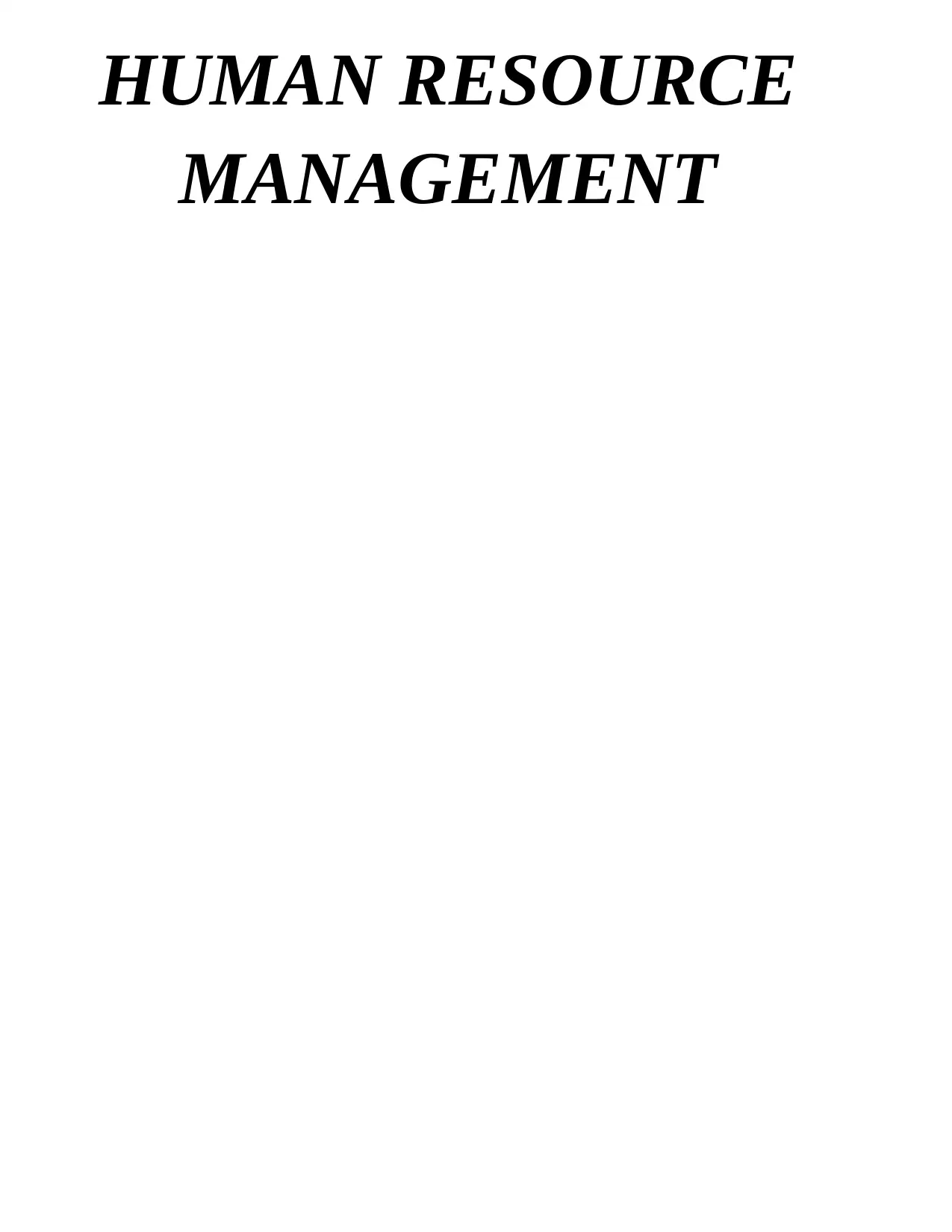
HUMAN RESOURCE
MANAGEMENT
MANAGEMENT
Paraphrase This Document
Need a fresh take? Get an instant paraphrase of this document with our AI Paraphraser
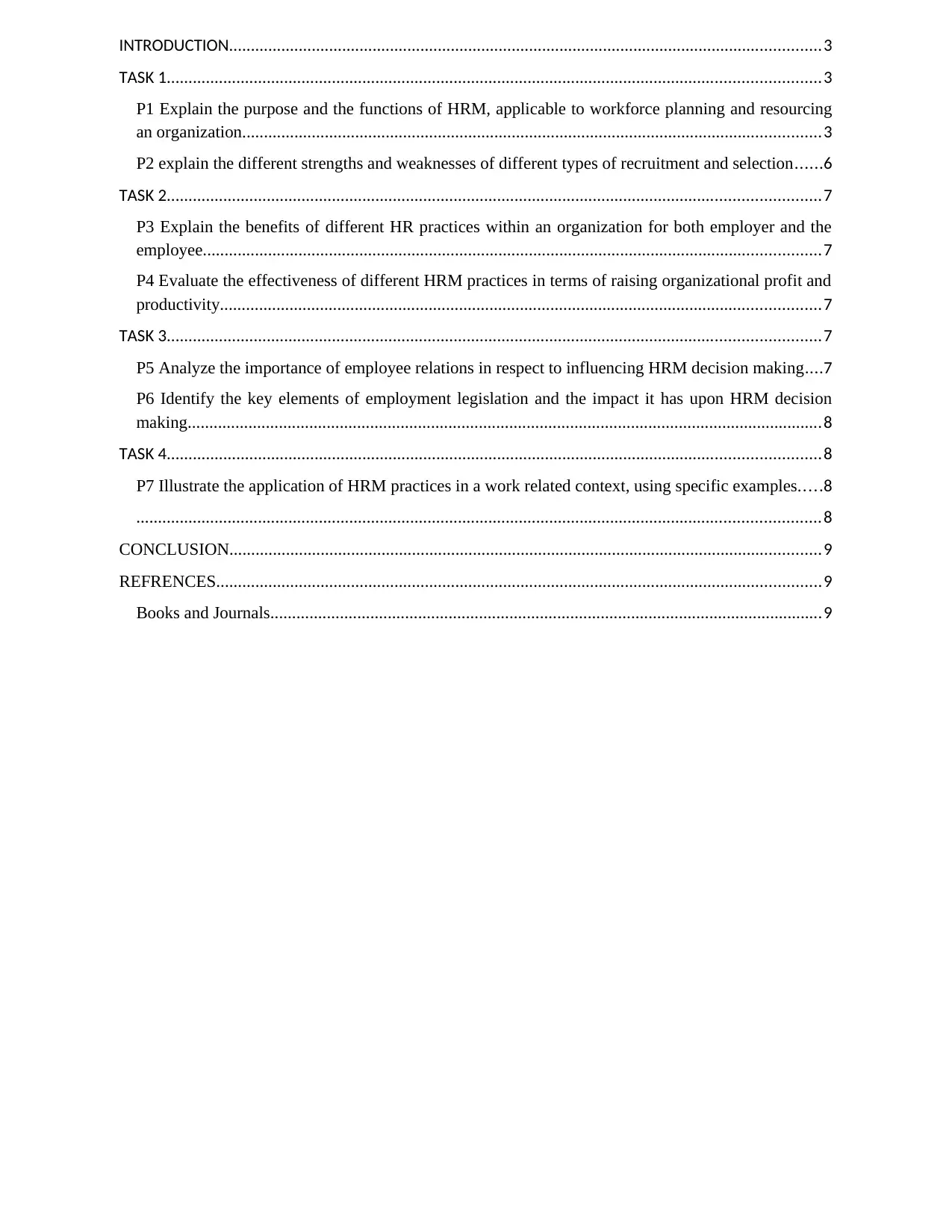
INTRODUCTION........................................................................................................................................3
TASK 1......................................................................................................................................................3
P1 Explain the purpose and the functions of HRM, applicable to workforce planning and resourcing
an organization.....................................................................................................................................3
P2 explain the different strengths and weaknesses of different types of recruitment and selection......6
TASK 2......................................................................................................................................................7
P3 Explain the benefits of different HR practices within an organization for both employer and the
employee..............................................................................................................................................7
P4 Evaluate the effectiveness of different HRM practices in terms of raising organizational profit and
productivity..........................................................................................................................................7
TASK 3......................................................................................................................................................7
P5 Analyze the importance of employee relations in respect to influencing HRM decision making....7
P6 Identify the key elements of employment legislation and the impact it has upon HRM decision
making..................................................................................................................................................8
TASK 4......................................................................................................................................................8
P7 Illustrate the application of HRM practices in a work related context, using specific examples.....8
.............................................................................................................................................................8
CONCLUSION........................................................................................................................................9
REFRENCES...........................................................................................................................................9
Books and Journals...............................................................................................................................9
TASK 1......................................................................................................................................................3
P1 Explain the purpose and the functions of HRM, applicable to workforce planning and resourcing
an organization.....................................................................................................................................3
P2 explain the different strengths and weaknesses of different types of recruitment and selection......6
TASK 2......................................................................................................................................................7
P3 Explain the benefits of different HR practices within an organization for both employer and the
employee..............................................................................................................................................7
P4 Evaluate the effectiveness of different HRM practices in terms of raising organizational profit and
productivity..........................................................................................................................................7
TASK 3......................................................................................................................................................7
P5 Analyze the importance of employee relations in respect to influencing HRM decision making....7
P6 Identify the key elements of employment legislation and the impact it has upon HRM decision
making..................................................................................................................................................8
TASK 4......................................................................................................................................................8
P7 Illustrate the application of HRM practices in a work related context, using specific examples.....8
.............................................................................................................................................................8
CONCLUSION........................................................................................................................................9
REFRENCES...........................................................................................................................................9
Books and Journals...............................................................................................................................9
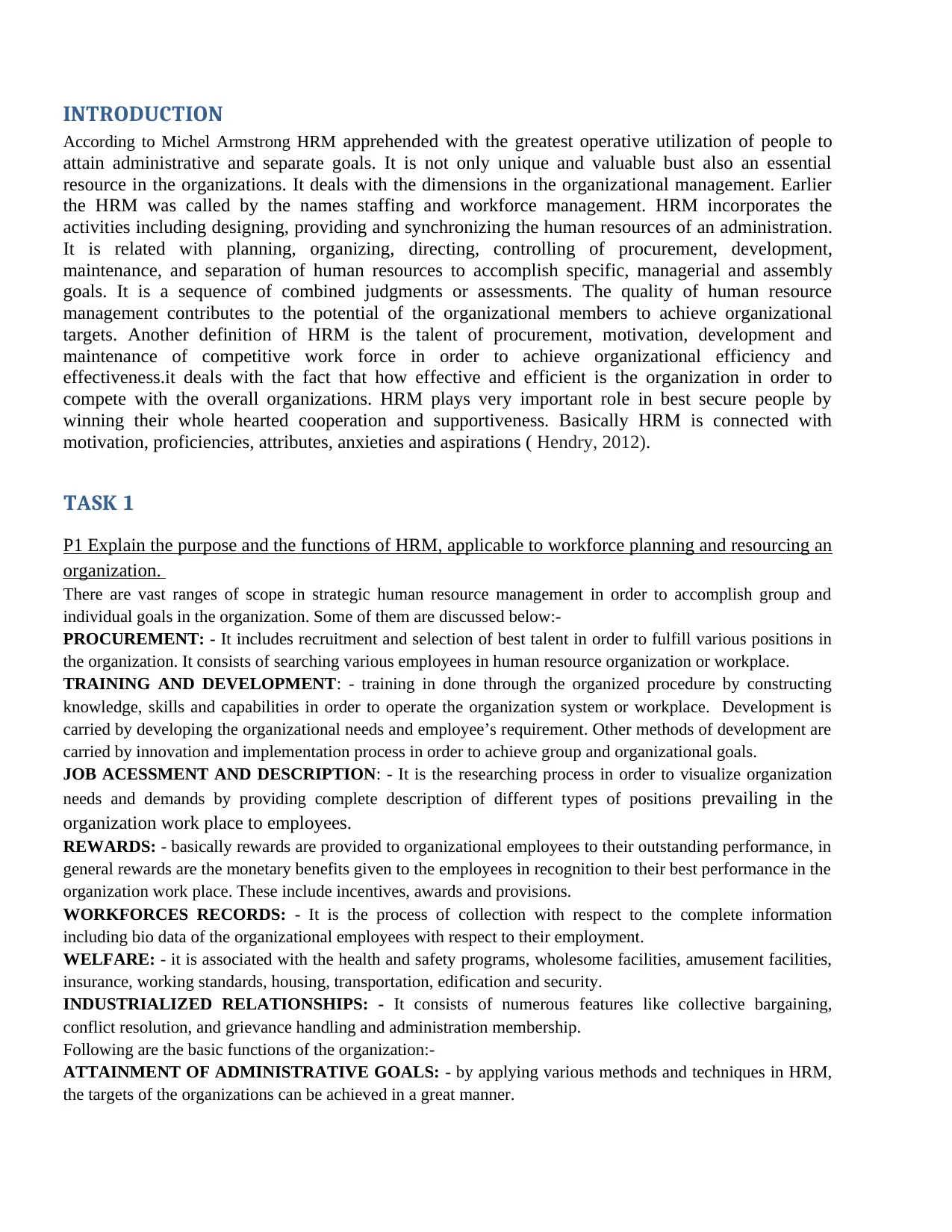
INTRODUCTION
According to Michel Armstrong HRM apprehended with the greatest operative utilization of people to
attain administrative and separate goals. It is not only unique and valuable bust also an essential
resource in the organizations. It deals with the dimensions in the organizational management. Earlier
the HRM was called by the names staffing and workforce management. HRM incorporates the
activities including designing, providing and synchronizing the human resources of an administration.
It is related with planning, organizing, directing, controlling of procurement, development,
maintenance, and separation of human resources to accomplish specific, managerial and assembly
goals. It is a sequence of combined judgments or assessments. The quality of human resource
management contributes to the potential of the organizational members to achieve organizational
targets. Another definition of HRM is the talent of procurement, motivation, development and
maintenance of competitive work force in order to achieve organizational efficiency and
effectiveness.it deals with the fact that how effective and efficient is the organization in order to
compete with the overall organizations. HRM plays very important role in best secure people by
winning their whole hearted cooperation and supportiveness. Basically HRM is connected with
motivation, proficiencies, attributes, anxieties and aspirations ( Hendry, 2012).
TASK 1
P1 Explain the purpose and the functions of HRM, applicable to workforce planning and resourcing an
organization.
There are vast ranges of scope in strategic human resource management in order to accomplish group and
individual goals in the organization. Some of them are discussed below:-
PROCUREMENT: - It includes recruitment and selection of best talent in order to fulfill various positions in
the organization. It consists of searching various employees in human resource organization or workplace.
TRAINING AND DEVELOPMENT: - training in done through the organized procedure by constructing
knowledge, skills and capabilities in order to operate the organization system or workplace. Development is
carried by developing the organizational needs and employee’s requirement. Other methods of development are
carried by innovation and implementation process in order to achieve group and organizational goals.
JOB ACESSMENT AND DESCRIPTION: - It is the researching process in order to visualize organization
needs and demands by providing complete description of different types of positions prevailing in the
organization work place to employees.
REWARDS: - basically rewards are provided to organizational employees to their outstanding performance, in
general rewards are the monetary benefits given to the employees in recognition to their best performance in the
organization work place. These include incentives, awards and provisions.
WORKFORCES RECORDS: - It is the process of collection with respect to the complete information
including bio data of the organizational employees with respect to their employment.
WELFARE: - it is associated with the health and safety programs, wholesome facilities, amusement facilities,
insurance, working standards, housing, transportation, edification and security.
INDUSTRIALIZED RELATIONSHIPS: - It consists of numerous features like collective bargaining,
conflict resolution, and grievance handling and administration membership.
Following are the basic functions of the organization:-
ATTAINMENT OF ADMINISTRATIVE GOALS: - by applying various methods and techniques in HRM,
the targets of the organizations can be achieved in a great manner.
According to Michel Armstrong HRM apprehended with the greatest operative utilization of people to
attain administrative and separate goals. It is not only unique and valuable bust also an essential
resource in the organizations. It deals with the dimensions in the organizational management. Earlier
the HRM was called by the names staffing and workforce management. HRM incorporates the
activities including designing, providing and synchronizing the human resources of an administration.
It is related with planning, organizing, directing, controlling of procurement, development,
maintenance, and separation of human resources to accomplish specific, managerial and assembly
goals. It is a sequence of combined judgments or assessments. The quality of human resource
management contributes to the potential of the organizational members to achieve organizational
targets. Another definition of HRM is the talent of procurement, motivation, development and
maintenance of competitive work force in order to achieve organizational efficiency and
effectiveness.it deals with the fact that how effective and efficient is the organization in order to
compete with the overall organizations. HRM plays very important role in best secure people by
winning their whole hearted cooperation and supportiveness. Basically HRM is connected with
motivation, proficiencies, attributes, anxieties and aspirations ( Hendry, 2012).
TASK 1
P1 Explain the purpose and the functions of HRM, applicable to workforce planning and resourcing an
organization.
There are vast ranges of scope in strategic human resource management in order to accomplish group and
individual goals in the organization. Some of them are discussed below:-
PROCUREMENT: - It includes recruitment and selection of best talent in order to fulfill various positions in
the organization. It consists of searching various employees in human resource organization or workplace.
TRAINING AND DEVELOPMENT: - training in done through the organized procedure by constructing
knowledge, skills and capabilities in order to operate the organization system or workplace. Development is
carried by developing the organizational needs and employee’s requirement. Other methods of development are
carried by innovation and implementation process in order to achieve group and organizational goals.
JOB ACESSMENT AND DESCRIPTION: - It is the researching process in order to visualize organization
needs and demands by providing complete description of different types of positions prevailing in the
organization work place to employees.
REWARDS: - basically rewards are provided to organizational employees to their outstanding performance, in
general rewards are the monetary benefits given to the employees in recognition to their best performance in the
organization work place. These include incentives, awards and provisions.
WORKFORCES RECORDS: - It is the process of collection with respect to the complete information
including bio data of the organizational employees with respect to their employment.
WELFARE: - it is associated with the health and safety programs, wholesome facilities, amusement facilities,
insurance, working standards, housing, transportation, edification and security.
INDUSTRIALIZED RELATIONSHIPS: - It consists of numerous features like collective bargaining,
conflict resolution, and grievance handling and administration membership.
Following are the basic functions of the organization:-
ATTAINMENT OF ADMINISTRATIVE GOALS: - by applying various methods and techniques in HRM,
the targets of the organizations can be achieved in a great manner.
⊘ This is a preview!⊘
Do you want full access?
Subscribe today to unlock all pages.

Trusted by 1+ million students worldwide
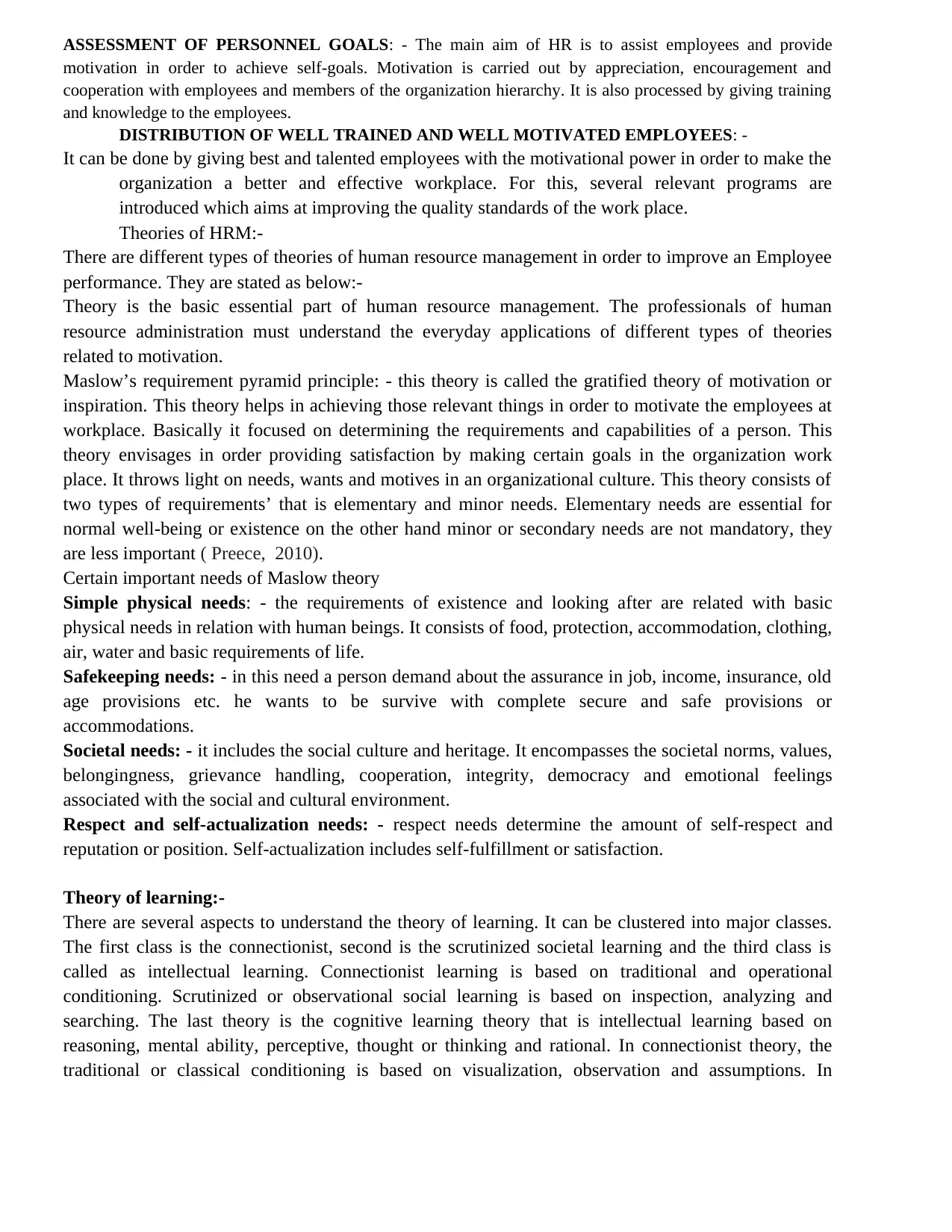
ASSESSMENT OF PERSONNEL GOALS: - The main aim of HR is to assist employees and provide
motivation in order to achieve self-goals. Motivation is carried out by appreciation, encouragement and
cooperation with employees and members of the organization hierarchy. It is also processed by giving training
and knowledge to the employees.
DISTRIBUTION OF WELL TRAINED AND WELL MOTIVATED EMPLOYEES: -
It can be done by giving best and talented employees with the motivational power in order to make the
organization a better and effective workplace. For this, several relevant programs are
introduced which aims at improving the quality standards of the work place.
Theories of HRM:-
There are different types of theories of human resource management in order to improve an Employee
performance. They are stated as below:-
Theory is the basic essential part of human resource management. The professionals of human
resource administration must understand the everyday applications of different types of theories
related to motivation.
Maslow’s requirement pyramid principle: - this theory is called the gratified theory of motivation or
inspiration. This theory helps in achieving those relevant things in order to motivate the employees at
workplace. Basically it focused on determining the requirements and capabilities of a person. This
theory envisages in order providing satisfaction by making certain goals in the organization work
place. It throws light on needs, wants and motives in an organizational culture. This theory consists of
two types of requirements’ that is elementary and minor needs. Elementary needs are essential for
normal well-being or existence on the other hand minor or secondary needs are not mandatory, they
are less important ( Preece, 2010).
Certain important needs of Maslow theory
Simple physical needs: - the requirements of existence and looking after are related with basic
physical needs in relation with human beings. It consists of food, protection, accommodation, clothing,
air, water and basic requirements of life.
Safekeeping needs: - in this need a person demand about the assurance in job, income, insurance, old
age provisions etc. he wants to be survive with complete secure and safe provisions or
accommodations.
Societal needs: - it includes the social culture and heritage. It encompasses the societal norms, values,
belongingness, grievance handling, cooperation, integrity, democracy and emotional feelings
associated with the social and cultural environment.
Respect and self-actualization needs: - respect needs determine the amount of self-respect and
reputation or position. Self-actualization includes self-fulfillment or satisfaction.
Theory of learning:-
There are several aspects to understand the theory of learning. It can be clustered into major classes.
The first class is the connectionist, second is the scrutinized societal learning and the third class is
called as intellectual learning. Connectionist learning is based on traditional and operational
conditioning. Scrutinized or observational social learning is based on inspection, analyzing and
searching. The last theory is the cognitive learning theory that is intellectual learning based on
reasoning, mental ability, perceptive, thought or thinking and rational. In connectionist theory, the
traditional or classical conditioning is based on visualization, observation and assumptions. In
motivation in order to achieve self-goals. Motivation is carried out by appreciation, encouragement and
cooperation with employees and members of the organization hierarchy. It is also processed by giving training
and knowledge to the employees.
DISTRIBUTION OF WELL TRAINED AND WELL MOTIVATED EMPLOYEES: -
It can be done by giving best and talented employees with the motivational power in order to make the
organization a better and effective workplace. For this, several relevant programs are
introduced which aims at improving the quality standards of the work place.
Theories of HRM:-
There are different types of theories of human resource management in order to improve an Employee
performance. They are stated as below:-
Theory is the basic essential part of human resource management. The professionals of human
resource administration must understand the everyday applications of different types of theories
related to motivation.
Maslow’s requirement pyramid principle: - this theory is called the gratified theory of motivation or
inspiration. This theory helps in achieving those relevant things in order to motivate the employees at
workplace. Basically it focused on determining the requirements and capabilities of a person. This
theory envisages in order providing satisfaction by making certain goals in the organization work
place. It throws light on needs, wants and motives in an organizational culture. This theory consists of
two types of requirements’ that is elementary and minor needs. Elementary needs are essential for
normal well-being or existence on the other hand minor or secondary needs are not mandatory, they
are less important ( Preece, 2010).
Certain important needs of Maslow theory
Simple physical needs: - the requirements of existence and looking after are related with basic
physical needs in relation with human beings. It consists of food, protection, accommodation, clothing,
air, water and basic requirements of life.
Safekeeping needs: - in this need a person demand about the assurance in job, income, insurance, old
age provisions etc. he wants to be survive with complete secure and safe provisions or
accommodations.
Societal needs: - it includes the social culture and heritage. It encompasses the societal norms, values,
belongingness, grievance handling, cooperation, integrity, democracy and emotional feelings
associated with the social and cultural environment.
Respect and self-actualization needs: - respect needs determine the amount of self-respect and
reputation or position. Self-actualization includes self-fulfillment or satisfaction.
Theory of learning:-
There are several aspects to understand the theory of learning. It can be clustered into major classes.
The first class is the connectionist, second is the scrutinized societal learning and the third class is
called as intellectual learning. Connectionist learning is based on traditional and operational
conditioning. Scrutinized or observational social learning is based on inspection, analyzing and
searching. The last theory is the cognitive learning theory that is intellectual learning based on
reasoning, mental ability, perceptive, thought or thinking and rational. In connectionist theory, the
traditional or classical conditioning is based on visualization, observation and assumptions. In
Paraphrase This Document
Need a fresh take? Get an instant paraphrase of this document with our AI Paraphraser
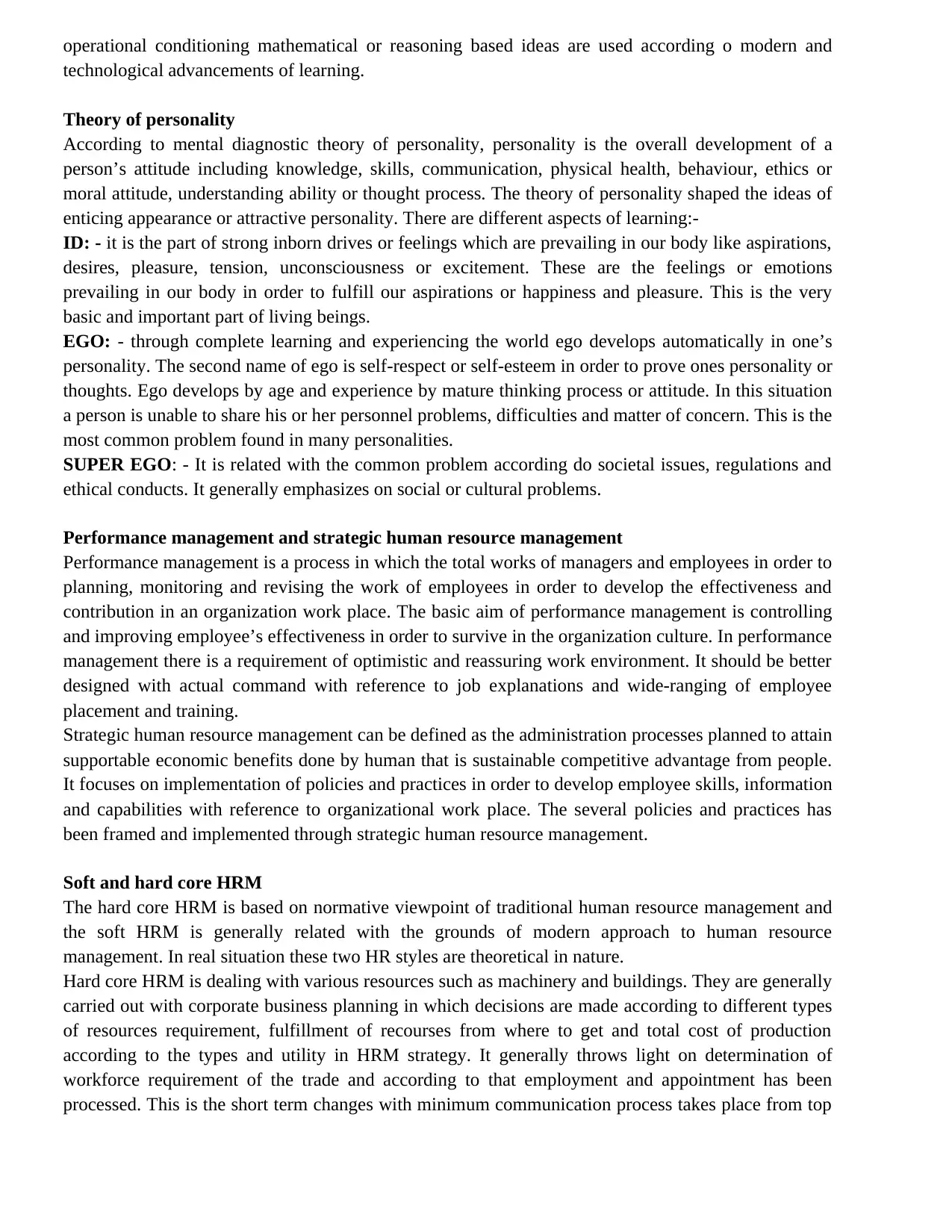
operational conditioning mathematical or reasoning based ideas are used according o modern and
technological advancements of learning.
Theory of personality
According to mental diagnostic theory of personality, personality is the overall development of a
person’s attitude including knowledge, skills, communication, physical health, behaviour, ethics or
moral attitude, understanding ability or thought process. The theory of personality shaped the ideas of
enticing appearance or attractive personality. There are different aspects of learning:-
ID: - it is the part of strong inborn drives or feelings which are prevailing in our body like aspirations,
desires, pleasure, tension, unconsciousness or excitement. These are the feelings or emotions
prevailing in our body in order to fulfill our aspirations or happiness and pleasure. This is the very
basic and important part of living beings.
EGO: - through complete learning and experiencing the world ego develops automatically in one’s
personality. The second name of ego is self-respect or self-esteem in order to prove ones personality or
thoughts. Ego develops by age and experience by mature thinking process or attitude. In this situation
a person is unable to share his or her personnel problems, difficulties and matter of concern. This is the
most common problem found in many personalities.
SUPER EGO: - It is related with the common problem according do societal issues, regulations and
ethical conducts. It generally emphasizes on social or cultural problems.
Performance management and strategic human resource management
Performance management is a process in which the total works of managers and employees in order to
planning, monitoring and revising the work of employees in order to develop the effectiveness and
contribution in an organization work place. The basic aim of performance management is controlling
and improving employee’s effectiveness in order to survive in the organization culture. In performance
management there is a requirement of optimistic and reassuring work environment. It should be better
designed with actual command with reference to job explanations and wide-ranging of employee
placement and training.
Strategic human resource management can be defined as the administration processes planned to attain
supportable economic benefits done by human that is sustainable competitive advantage from people.
It focuses on implementation of policies and practices in order to develop employee skills, information
and capabilities with reference to organizational work place. The several policies and practices has
been framed and implemented through strategic human resource management.
Soft and hard core HRM
The hard core HRM is based on normative viewpoint of traditional human resource management and
the soft HRM is generally related with the grounds of modern approach to human resource
management. In real situation these two HR styles are theoretical in nature.
Hard core HRM is dealing with various resources such as machinery and buildings. They are generally
carried out with corporate business planning in which decisions are made according to different types
of resources requirement, fulfillment of recourses from where to get and total cost of production
according to the types and utility in HRM strategy. It generally throws light on determination of
workforce requirement of the trade and according to that employment and appointment has been
processed. This is the short term changes with minimum communication process takes place from top
technological advancements of learning.
Theory of personality
According to mental diagnostic theory of personality, personality is the overall development of a
person’s attitude including knowledge, skills, communication, physical health, behaviour, ethics or
moral attitude, understanding ability or thought process. The theory of personality shaped the ideas of
enticing appearance or attractive personality. There are different aspects of learning:-
ID: - it is the part of strong inborn drives or feelings which are prevailing in our body like aspirations,
desires, pleasure, tension, unconsciousness or excitement. These are the feelings or emotions
prevailing in our body in order to fulfill our aspirations or happiness and pleasure. This is the very
basic and important part of living beings.
EGO: - through complete learning and experiencing the world ego develops automatically in one’s
personality. The second name of ego is self-respect or self-esteem in order to prove ones personality or
thoughts. Ego develops by age and experience by mature thinking process or attitude. In this situation
a person is unable to share his or her personnel problems, difficulties and matter of concern. This is the
most common problem found in many personalities.
SUPER EGO: - It is related with the common problem according do societal issues, regulations and
ethical conducts. It generally emphasizes on social or cultural problems.
Performance management and strategic human resource management
Performance management is a process in which the total works of managers and employees in order to
planning, monitoring and revising the work of employees in order to develop the effectiveness and
contribution in an organization work place. The basic aim of performance management is controlling
and improving employee’s effectiveness in order to survive in the organization culture. In performance
management there is a requirement of optimistic and reassuring work environment. It should be better
designed with actual command with reference to job explanations and wide-ranging of employee
placement and training.
Strategic human resource management can be defined as the administration processes planned to attain
supportable economic benefits done by human that is sustainable competitive advantage from people.
It focuses on implementation of policies and practices in order to develop employee skills, information
and capabilities with reference to organizational work place. The several policies and practices has
been framed and implemented through strategic human resource management.
Soft and hard core HRM
The hard core HRM is based on normative viewpoint of traditional human resource management and
the soft HRM is generally related with the grounds of modern approach to human resource
management. In real situation these two HR styles are theoretical in nature.
Hard core HRM is dealing with various resources such as machinery and buildings. They are generally
carried out with corporate business planning in which decisions are made according to different types
of resources requirement, fulfillment of recourses from where to get and total cost of production
according to the types and utility in HRM strategy. It generally throws light on determination of
workforce requirement of the trade and according to that employment and appointment has been
processed. This is the short term changes with minimum communication process takes place from top
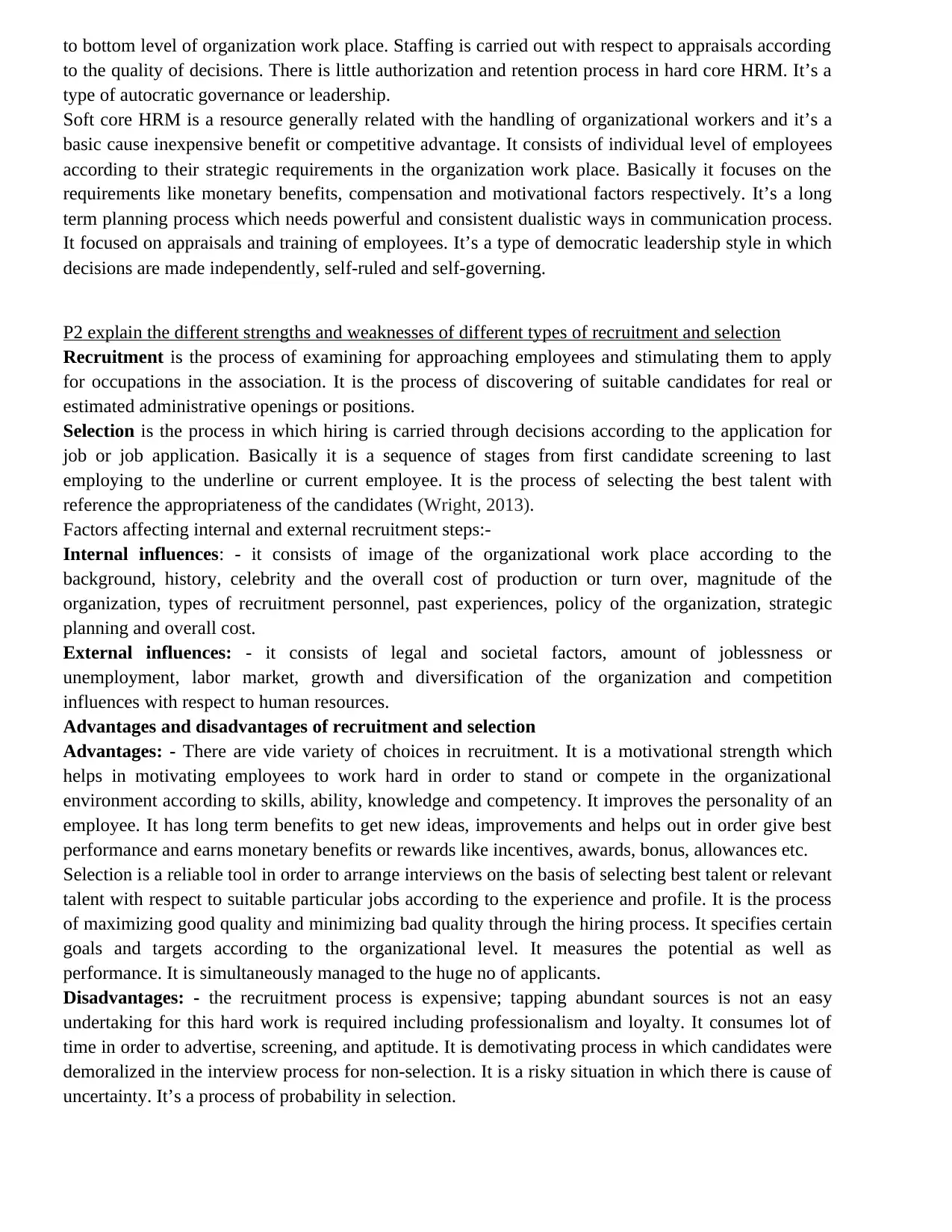
to bottom level of organization work place. Staffing is carried out with respect to appraisals according
to the quality of decisions. There is little authorization and retention process in hard core HRM. It’s a
type of autocratic governance or leadership.
Soft core HRM is a resource generally related with the handling of organizational workers and it’s a
basic cause inexpensive benefit or competitive advantage. It consists of individual level of employees
according to their strategic requirements in the organization work place. Basically it focuses on the
requirements like monetary benefits, compensation and motivational factors respectively. It’s a long
term planning process which needs powerful and consistent dualistic ways in communication process.
It focused on appraisals and training of employees. It’s a type of democratic leadership style in which
decisions are made independently, self-ruled and self-governing.
P2 explain the different strengths and weaknesses of different types of recruitment and selection
Recruitment is the process of examining for approaching employees and stimulating them to apply
for occupations in the association. It is the process of discovering of suitable candidates for real or
estimated administrative openings or positions.
Selection is the process in which hiring is carried through decisions according to the application for
job or job application. Basically it is a sequence of stages from first candidate screening to last
employing to the underline or current employee. It is the process of selecting the best talent with
reference the appropriateness of the candidates (Wright, 2013).
Factors affecting internal and external recruitment steps:-
Internal influences: - it consists of image of the organizational work place according to the
background, history, celebrity and the overall cost of production or turn over, magnitude of the
organization, types of recruitment personnel, past experiences, policy of the organization, strategic
planning and overall cost.
External influences: - it consists of legal and societal factors, amount of joblessness or
unemployment, labor market, growth and diversification of the organization and competition
influences with respect to human resources.
Advantages and disadvantages of recruitment and selection
Advantages: - There are vide variety of choices in recruitment. It is a motivational strength which
helps in motivating employees to work hard in order to stand or compete in the organizational
environment according to skills, ability, knowledge and competency. It improves the personality of an
employee. It has long term benefits to get new ideas, improvements and helps out in order give best
performance and earns monetary benefits or rewards like incentives, awards, bonus, allowances etc.
Selection is a reliable tool in order to arrange interviews on the basis of selecting best talent or relevant
talent with respect to suitable particular jobs according to the experience and profile. It is the process
of maximizing good quality and minimizing bad quality through the hiring process. It specifies certain
goals and targets according to the organizational level. It measures the potential as well as
performance. It is simultaneously managed to the huge no of applicants.
Disadvantages: - the recruitment process is expensive; tapping abundant sources is not an easy
undertaking for this hard work is required including professionalism and loyalty. It consumes lot of
time in order to advertise, screening, and aptitude. It is demotivating process in which candidates were
demoralized in the interview process for non-selection. It is a risky situation in which there is cause of
uncertainty. It’s a process of probability in selection.
to the quality of decisions. There is little authorization and retention process in hard core HRM. It’s a
type of autocratic governance or leadership.
Soft core HRM is a resource generally related with the handling of organizational workers and it’s a
basic cause inexpensive benefit or competitive advantage. It consists of individual level of employees
according to their strategic requirements in the organization work place. Basically it focuses on the
requirements like monetary benefits, compensation and motivational factors respectively. It’s a long
term planning process which needs powerful and consistent dualistic ways in communication process.
It focused on appraisals and training of employees. It’s a type of democratic leadership style in which
decisions are made independently, self-ruled and self-governing.
P2 explain the different strengths and weaknesses of different types of recruitment and selection
Recruitment is the process of examining for approaching employees and stimulating them to apply
for occupations in the association. It is the process of discovering of suitable candidates for real or
estimated administrative openings or positions.
Selection is the process in which hiring is carried through decisions according to the application for
job or job application. Basically it is a sequence of stages from first candidate screening to last
employing to the underline or current employee. It is the process of selecting the best talent with
reference the appropriateness of the candidates (Wright, 2013).
Factors affecting internal and external recruitment steps:-
Internal influences: - it consists of image of the organizational work place according to the
background, history, celebrity and the overall cost of production or turn over, magnitude of the
organization, types of recruitment personnel, past experiences, policy of the organization, strategic
planning and overall cost.
External influences: - it consists of legal and societal factors, amount of joblessness or
unemployment, labor market, growth and diversification of the organization and competition
influences with respect to human resources.
Advantages and disadvantages of recruitment and selection
Advantages: - There are vide variety of choices in recruitment. It is a motivational strength which
helps in motivating employees to work hard in order to stand or compete in the organizational
environment according to skills, ability, knowledge and competency. It improves the personality of an
employee. It has long term benefits to get new ideas, improvements and helps out in order give best
performance and earns monetary benefits or rewards like incentives, awards, bonus, allowances etc.
Selection is a reliable tool in order to arrange interviews on the basis of selecting best talent or relevant
talent with respect to suitable particular jobs according to the experience and profile. It is the process
of maximizing good quality and minimizing bad quality through the hiring process. It specifies certain
goals and targets according to the organizational level. It measures the potential as well as
performance. It is simultaneously managed to the huge no of applicants.
Disadvantages: - the recruitment process is expensive; tapping abundant sources is not an easy
undertaking for this hard work is required including professionalism and loyalty. It consumes lot of
time in order to advertise, screening, and aptitude. It is demotivating process in which candidates were
demoralized in the interview process for non-selection. It is a risky situation in which there is cause of
uncertainty. It’s a process of probability in selection.
⊘ This is a preview!⊘
Do you want full access?
Subscribe today to unlock all pages.

Trusted by 1+ million students worldwide
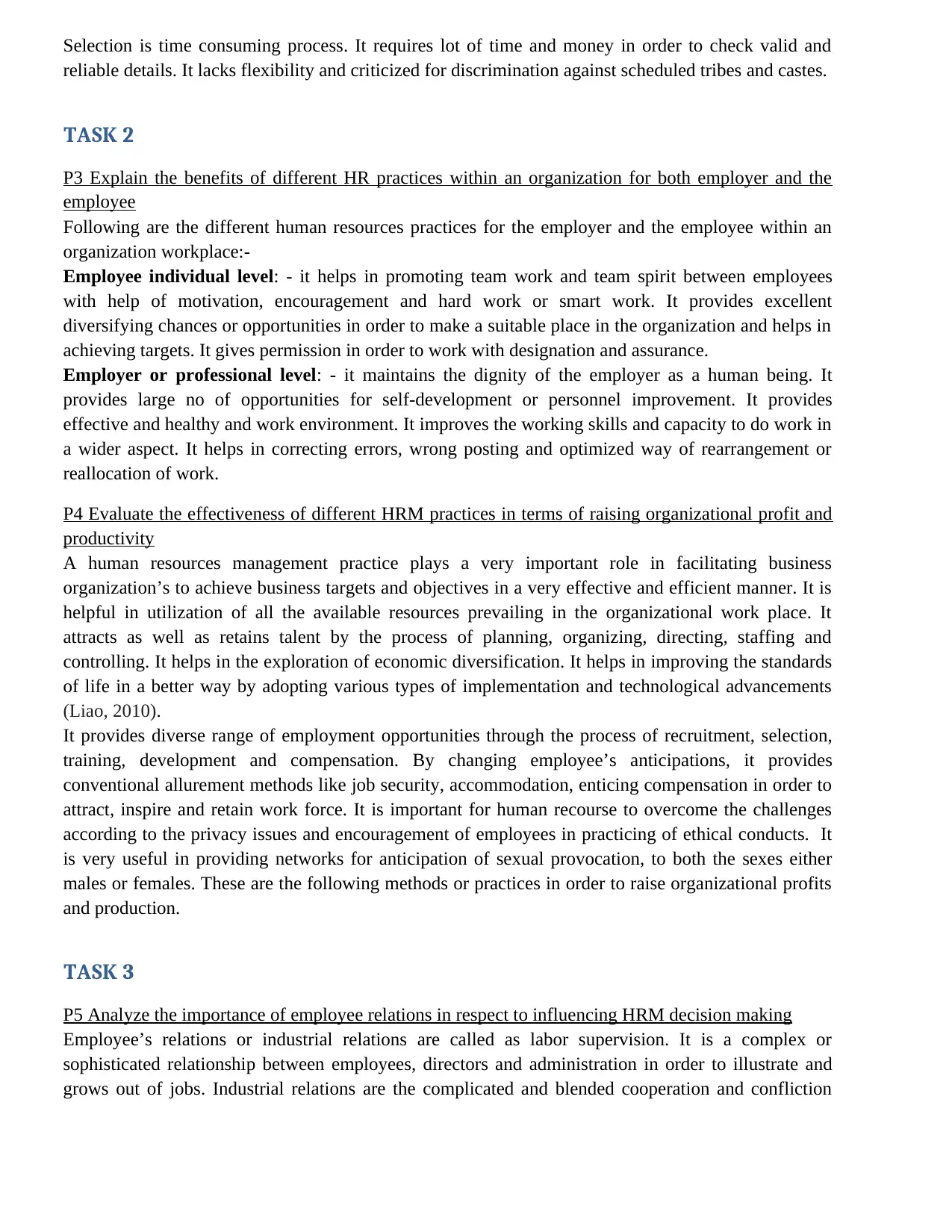
Selection is time consuming process. It requires lot of time and money in order to check valid and
reliable details. It lacks flexibility and criticized for discrimination against scheduled tribes and castes.
TASK 2
P3 Explain the benefits of different HR practices within an organization for both employer and the
employee
Following are the different human resources practices for the employer and the employee within an
organization workplace:-
Employee individual level: - it helps in promoting team work and team spirit between employees
with help of motivation, encouragement and hard work or smart work. It provides excellent
diversifying chances or opportunities in order to make a suitable place in the organization and helps in
achieving targets. It gives permission in order to work with designation and assurance.
Employer or professional level: - it maintains the dignity of the employer as a human being. It
provides large no of opportunities for self-development or personnel improvement. It provides
effective and healthy and work environment. It improves the working skills and capacity to do work in
a wider aspect. It helps in correcting errors, wrong posting and optimized way of rearrangement or
reallocation of work.
P4 Evaluate the effectiveness of different HRM practices in terms of raising organizational profit and
productivity
A human resources management practice plays a very important role in facilitating business
organization’s to achieve business targets and objectives in a very effective and efficient manner. It is
helpful in utilization of all the available resources prevailing in the organizational work place. It
attracts as well as retains talent by the process of planning, organizing, directing, staffing and
controlling. It helps in the exploration of economic diversification. It helps in improving the standards
of life in a better way by adopting various types of implementation and technological advancements
(Liao, 2010).
It provides diverse range of employment opportunities through the process of recruitment, selection,
training, development and compensation. By changing employee’s anticipations, it provides
conventional allurement methods like job security, accommodation, enticing compensation in order to
attract, inspire and retain work force. It is important for human recourse to overcome the challenges
according to the privacy issues and encouragement of employees in practicing of ethical conducts. It
is very useful in providing networks for anticipation of sexual provocation, to both the sexes either
males or females. These are the following methods or practices in order to raise organizational profits
and production.
TASK 3
P5 Analyze the importance of employee relations in respect to influencing HRM decision making
Employee’s relations or industrial relations are called as labor supervision. It is a complex or
sophisticated relationship between employees, directors and administration in order to illustrate and
grows out of jobs. Industrial relations are the complicated and blended cooperation and confliction
reliable details. It lacks flexibility and criticized for discrimination against scheduled tribes and castes.
TASK 2
P3 Explain the benefits of different HR practices within an organization for both employer and the
employee
Following are the different human resources practices for the employer and the employee within an
organization workplace:-
Employee individual level: - it helps in promoting team work and team spirit between employees
with help of motivation, encouragement and hard work or smart work. It provides excellent
diversifying chances or opportunities in order to make a suitable place in the organization and helps in
achieving targets. It gives permission in order to work with designation and assurance.
Employer or professional level: - it maintains the dignity of the employer as a human being. It
provides large no of opportunities for self-development or personnel improvement. It provides
effective and healthy and work environment. It improves the working skills and capacity to do work in
a wider aspect. It helps in correcting errors, wrong posting and optimized way of rearrangement or
reallocation of work.
P4 Evaluate the effectiveness of different HRM practices in terms of raising organizational profit and
productivity
A human resources management practice plays a very important role in facilitating business
organization’s to achieve business targets and objectives in a very effective and efficient manner. It is
helpful in utilization of all the available resources prevailing in the organizational work place. It
attracts as well as retains talent by the process of planning, organizing, directing, staffing and
controlling. It helps in the exploration of economic diversification. It helps in improving the standards
of life in a better way by adopting various types of implementation and technological advancements
(Liao, 2010).
It provides diverse range of employment opportunities through the process of recruitment, selection,
training, development and compensation. By changing employee’s anticipations, it provides
conventional allurement methods like job security, accommodation, enticing compensation in order to
attract, inspire and retain work force. It is important for human recourse to overcome the challenges
according to the privacy issues and encouragement of employees in practicing of ethical conducts. It
is very useful in providing networks for anticipation of sexual provocation, to both the sexes either
males or females. These are the following methods or practices in order to raise organizational profits
and production.
TASK 3
P5 Analyze the importance of employee relations in respect to influencing HRM decision making
Employee’s relations or industrial relations are called as labor supervision. It is a complex or
sophisticated relationship between employees, directors and administration in order to illustrate and
grows out of jobs. Industrial relations are the complicated and blended cooperation and confliction
Paraphrase This Document
Need a fresh take? Get an instant paraphrase of this document with our AI Paraphraser
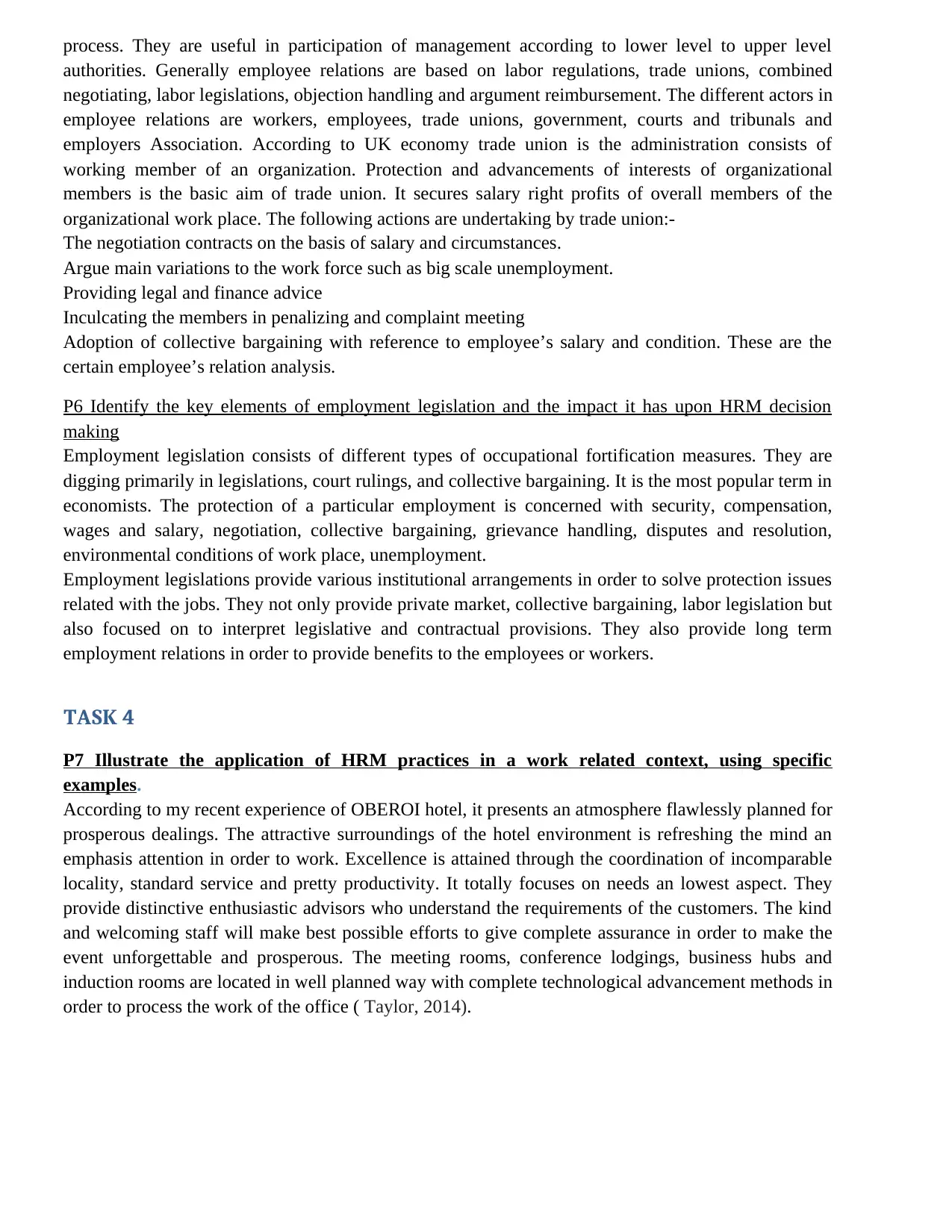
process. They are useful in participation of management according to lower level to upper level
authorities. Generally employee relations are based on labor regulations, trade unions, combined
negotiating, labor legislations, objection handling and argument reimbursement. The different actors in
employee relations are workers, employees, trade unions, government, courts and tribunals and
employers Association. According to UK economy trade union is the administration consists of
working member of an organization. Protection and advancements of interests of organizational
members is the basic aim of trade union. It secures salary right profits of overall members of the
organizational work place. The following actions are undertaking by trade union:-
The negotiation contracts on the basis of salary and circumstances.
Argue main variations to the work force such as big scale unemployment.
Providing legal and finance advice
Inculcating the members in penalizing and complaint meeting
Adoption of collective bargaining with reference to employee’s salary and condition. These are the
certain employee’s relation analysis.
P6 Identify the key elements of employment legislation and the impact it has upon HRM decision
making
Employment legislation consists of different types of occupational fortification measures. They are
digging primarily in legislations, court rulings, and collective bargaining. It is the most popular term in
economists. The protection of a particular employment is concerned with security, compensation,
wages and salary, negotiation, collective bargaining, grievance handling, disputes and resolution,
environmental conditions of work place, unemployment.
Employment legislations provide various institutional arrangements in order to solve protection issues
related with the jobs. They not only provide private market, collective bargaining, labor legislation but
also focused on to interpret legislative and contractual provisions. They also provide long term
employment relations in order to provide benefits to the employees or workers.
TASK 4
P7 Illustrate the application of HRM practices in a work related context, using specific
examples.
According to my recent experience of OBEROI hotel, it presents an atmosphere flawlessly planned for
prosperous dealings. The attractive surroundings of the hotel environment is refreshing the mind an
emphasis attention in order to work. Excellence is attained through the coordination of incomparable
locality, standard service and pretty productivity. It totally focuses on needs an lowest aspect. They
provide distinctive enthusiastic advisors who understand the requirements of the customers. The kind
and welcoming staff will make best possible efforts to give complete assurance in order to make the
event unforgettable and prosperous. The meeting rooms, conference lodgings, business hubs and
induction rooms are located in well planned way with complete technological advancement methods in
order to process the work of the office ( Taylor, 2014).
authorities. Generally employee relations are based on labor regulations, trade unions, combined
negotiating, labor legislations, objection handling and argument reimbursement. The different actors in
employee relations are workers, employees, trade unions, government, courts and tribunals and
employers Association. According to UK economy trade union is the administration consists of
working member of an organization. Protection and advancements of interests of organizational
members is the basic aim of trade union. It secures salary right profits of overall members of the
organizational work place. The following actions are undertaking by trade union:-
The negotiation contracts on the basis of salary and circumstances.
Argue main variations to the work force such as big scale unemployment.
Providing legal and finance advice
Inculcating the members in penalizing and complaint meeting
Adoption of collective bargaining with reference to employee’s salary and condition. These are the
certain employee’s relation analysis.
P6 Identify the key elements of employment legislation and the impact it has upon HRM decision
making
Employment legislation consists of different types of occupational fortification measures. They are
digging primarily in legislations, court rulings, and collective bargaining. It is the most popular term in
economists. The protection of a particular employment is concerned with security, compensation,
wages and salary, negotiation, collective bargaining, grievance handling, disputes and resolution,
environmental conditions of work place, unemployment.
Employment legislations provide various institutional arrangements in order to solve protection issues
related with the jobs. They not only provide private market, collective bargaining, labor legislation but
also focused on to interpret legislative and contractual provisions. They also provide long term
employment relations in order to provide benefits to the employees or workers.
TASK 4
P7 Illustrate the application of HRM practices in a work related context, using specific
examples.
According to my recent experience of OBEROI hotel, it presents an atmosphere flawlessly planned for
prosperous dealings. The attractive surroundings of the hotel environment is refreshing the mind an
emphasis attention in order to work. Excellence is attained through the coordination of incomparable
locality, standard service and pretty productivity. It totally focuses on needs an lowest aspect. They
provide distinctive enthusiastic advisors who understand the requirements of the customers. The kind
and welcoming staff will make best possible efforts to give complete assurance in order to make the
event unforgettable and prosperous. The meeting rooms, conference lodgings, business hubs and
induction rooms are located in well planned way with complete technological advancement methods in
order to process the work of the office ( Taylor, 2014).
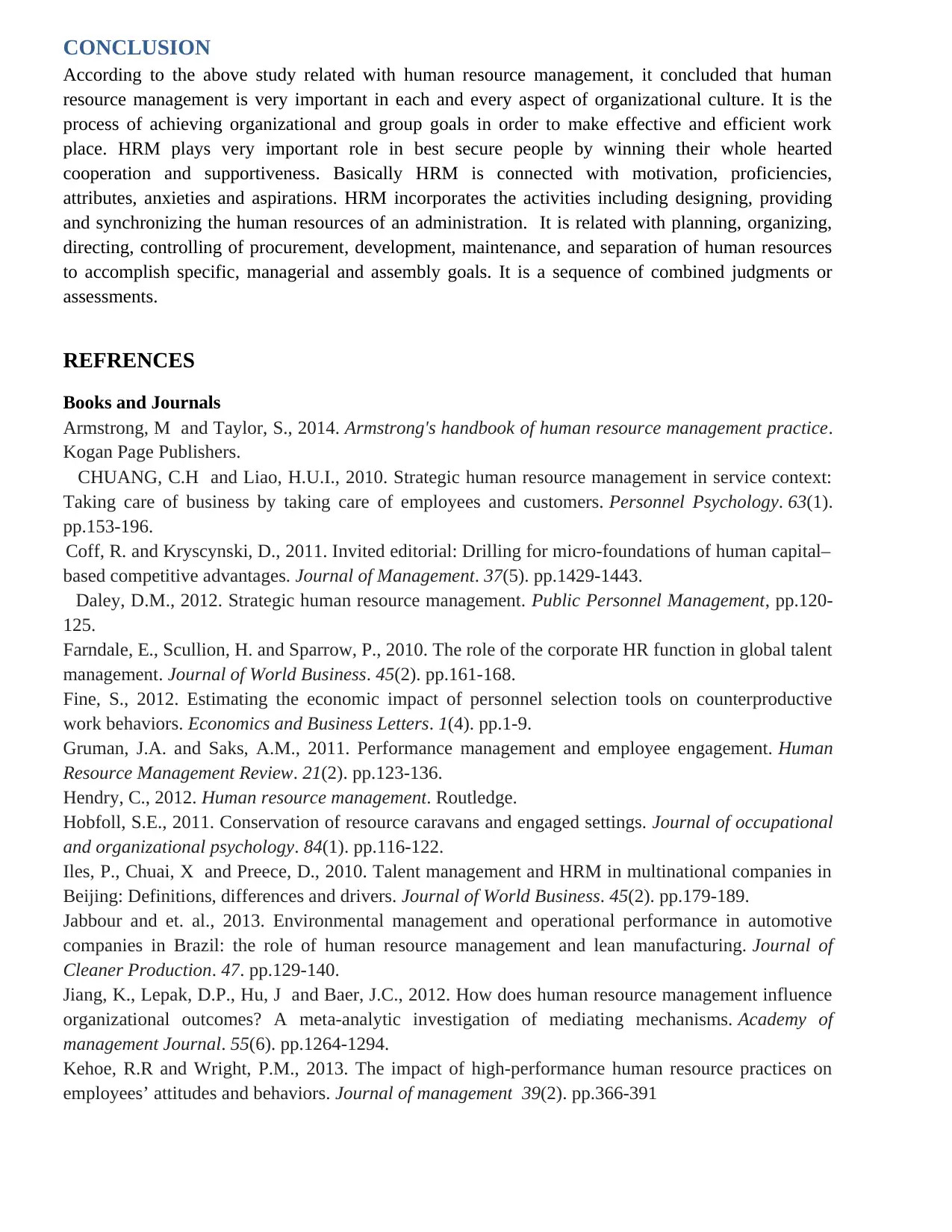
CONCLUSION
According to the above study related with human resource management, it concluded that human
resource management is very important in each and every aspect of organizational culture. It is the
process of achieving organizational and group goals in order to make effective and efficient work
place. HRM plays very important role in best secure people by winning their whole hearted
cooperation and supportiveness. Basically HRM is connected with motivation, proficiencies,
attributes, anxieties and aspirations. HRM incorporates the activities including designing, providing
and synchronizing the human resources of an administration. It is related with planning, organizing,
directing, controlling of procurement, development, maintenance, and separation of human resources
to accomplish specific, managerial and assembly goals. It is a sequence of combined judgments or
assessments.
REFRENCES
Books and Journals
Armstrong, M and Taylor, S., 2014. Armstrong's handbook of human resource management practice.
Kogan Page Publishers.
CHUANG, C.H and Liao, H.U.I., 2010. Strategic human resource management in service context:
Taking care of business by taking care of employees and customers. Personnel Psychology. 63(1).
pp.153-196.
Coff, R. and Kryscynski, D., 2011. Invited editorial: Drilling for micro-foundations of human capital–
based competitive advantages. Journal of Management. 37(5). pp.1429-1443.
Daley, D.M., 2012. Strategic human resource management. Public Personnel Management, pp.120-
125.
Farndale, E., Scullion, H. and Sparrow, P., 2010. The role of the corporate HR function in global talent
management. Journal of World Business. 45(2). pp.161-168.
Fine, S., 2012. Estimating the economic impact of personnel selection tools on counterproductive
work behaviors. Economics and Business Letters. 1(4). pp.1-9.
Gruman, J.A. and Saks, A.M., 2011. Performance management and employee engagement. Human
Resource Management Review. 21(2). pp.123-136.
Hendry, C., 2012. Human resource management. Routledge.
Hobfoll, S.E., 2011. Conservation of resource caravans and engaged settings. Journal of occupational
and organizational psychology. 84(1). pp.116-122.
Iles, P., Chuai, X and Preece, D., 2010. Talent management and HRM in multinational companies in
Beijing: Definitions, differences and drivers. Journal of World Business. 45(2). pp.179-189.
Jabbour and et. al., 2013. Environmental management and operational performance in automotive
companies in Brazil: the role of human resource management and lean manufacturing. Journal of
Cleaner Production. 47. pp.129-140.
Jiang, K., Lepak, D.P., Hu, J and Baer, J.C., 2012. How does human resource management influence
organizational outcomes? A meta-analytic investigation of mediating mechanisms. Academy of
management Journal. 55(6). pp.1264-1294.
Kehoe, R.R and Wright, P.M., 2013. The impact of high-performance human resource practices on
employees’ attitudes and behaviors. Journal of management 39(2). pp.366-391
According to the above study related with human resource management, it concluded that human
resource management is very important in each and every aspect of organizational culture. It is the
process of achieving organizational and group goals in order to make effective and efficient work
place. HRM plays very important role in best secure people by winning their whole hearted
cooperation and supportiveness. Basically HRM is connected with motivation, proficiencies,
attributes, anxieties and aspirations. HRM incorporates the activities including designing, providing
and synchronizing the human resources of an administration. It is related with planning, organizing,
directing, controlling of procurement, development, maintenance, and separation of human resources
to accomplish specific, managerial and assembly goals. It is a sequence of combined judgments or
assessments.
REFRENCES
Books and Journals
Armstrong, M and Taylor, S., 2014. Armstrong's handbook of human resource management practice.
Kogan Page Publishers.
CHUANG, C.H and Liao, H.U.I., 2010. Strategic human resource management in service context:
Taking care of business by taking care of employees and customers. Personnel Psychology. 63(1).
pp.153-196.
Coff, R. and Kryscynski, D., 2011. Invited editorial: Drilling for micro-foundations of human capital–
based competitive advantages. Journal of Management. 37(5). pp.1429-1443.
Daley, D.M., 2012. Strategic human resource management. Public Personnel Management, pp.120-
125.
Farndale, E., Scullion, H. and Sparrow, P., 2010. The role of the corporate HR function in global talent
management. Journal of World Business. 45(2). pp.161-168.
Fine, S., 2012. Estimating the economic impact of personnel selection tools on counterproductive
work behaviors. Economics and Business Letters. 1(4). pp.1-9.
Gruman, J.A. and Saks, A.M., 2011. Performance management and employee engagement. Human
Resource Management Review. 21(2). pp.123-136.
Hendry, C., 2012. Human resource management. Routledge.
Hobfoll, S.E., 2011. Conservation of resource caravans and engaged settings. Journal of occupational
and organizational psychology. 84(1). pp.116-122.
Iles, P., Chuai, X and Preece, D., 2010. Talent management and HRM in multinational companies in
Beijing: Definitions, differences and drivers. Journal of World Business. 45(2). pp.179-189.
Jabbour and et. al., 2013. Environmental management and operational performance in automotive
companies in Brazil: the role of human resource management and lean manufacturing. Journal of
Cleaner Production. 47. pp.129-140.
Jiang, K., Lepak, D.P., Hu, J and Baer, J.C., 2012. How does human resource management influence
organizational outcomes? A meta-analytic investigation of mediating mechanisms. Academy of
management Journal. 55(6). pp.1264-1294.
Kehoe, R.R and Wright, P.M., 2013. The impact of high-performance human resource practices on
employees’ attitudes and behaviors. Journal of management 39(2). pp.366-391
⊘ This is a preview!⊘
Do you want full access?
Subscribe today to unlock all pages.

Trusted by 1+ million students worldwide
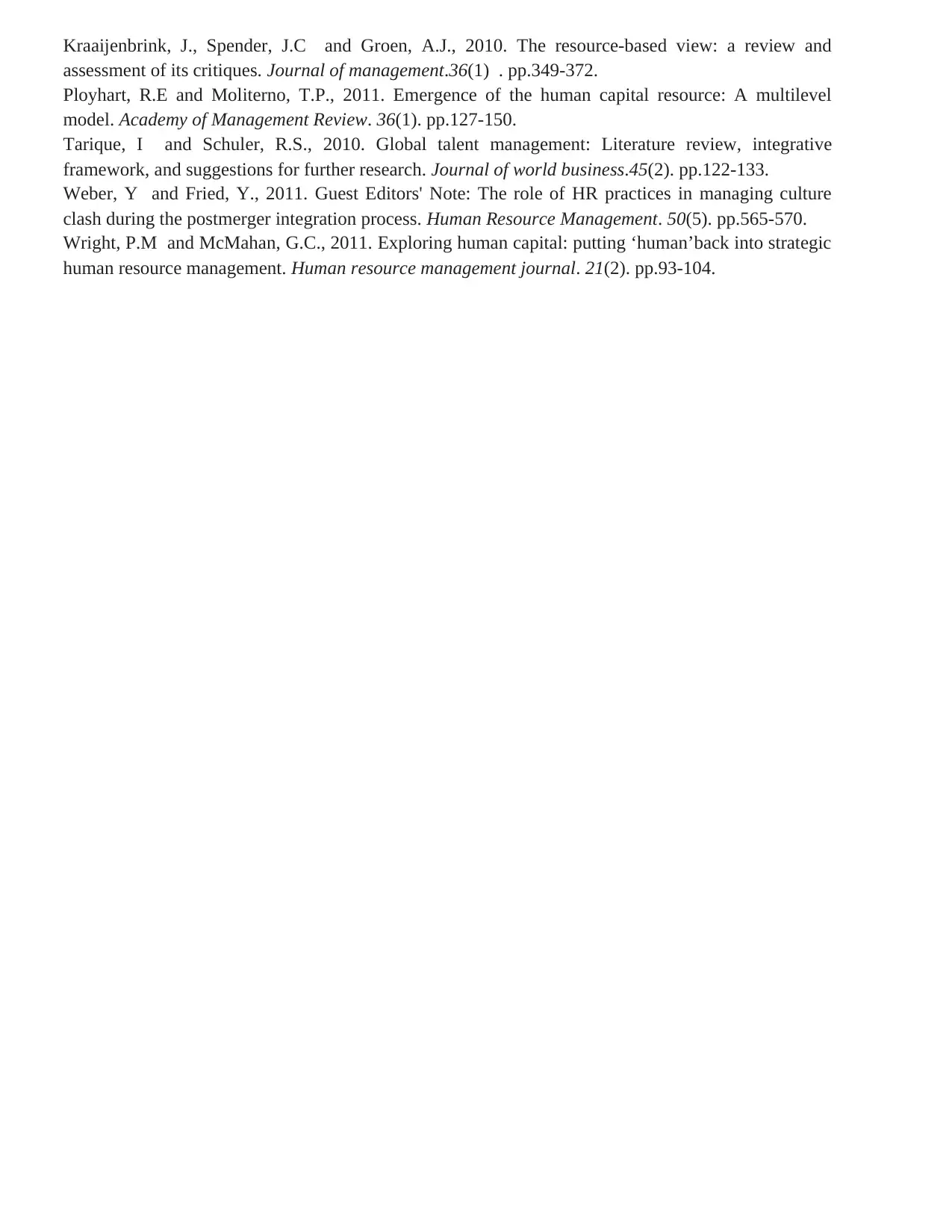
Kraaijenbrink, J., Spender, J.C and Groen, A.J., 2010. The resource-based view: a review and
assessment of its critiques. Journal of management.36(1) . pp.349-372.
Ployhart, R.E and Moliterno, T.P., 2011. Emergence of the human capital resource: A multilevel
model. Academy of Management Review. 36(1). pp.127-150.
Tarique, I and Schuler, R.S., 2010. Global talent management: Literature review, integrative
framework, and suggestions for further research. Journal of world business.45(2). pp.122-133.
Weber, Y and Fried, Y., 2011. Guest Editors' Note: The role of HR practices in managing culture
clash during the postmerger integration process. Human Resource Management. 50(5). pp.565-570.
Wright, P.M and McMahan, G.C., 2011. Exploring human capital: putting ‘human’back into strategic
human resource management. Human resource management journal. 21(2). pp.93-104.
assessment of its critiques. Journal of management.36(1) . pp.349-372.
Ployhart, R.E and Moliterno, T.P., 2011. Emergence of the human capital resource: A multilevel
model. Academy of Management Review. 36(1). pp.127-150.
Tarique, I and Schuler, R.S., 2010. Global talent management: Literature review, integrative
framework, and suggestions for further research. Journal of world business.45(2). pp.122-133.
Weber, Y and Fried, Y., 2011. Guest Editors' Note: The role of HR practices in managing culture
clash during the postmerger integration process. Human Resource Management. 50(5). pp.565-570.
Wright, P.M and McMahan, G.C., 2011. Exploring human capital: putting ‘human’back into strategic
human resource management. Human resource management journal. 21(2). pp.93-104.
1 out of 10
Related Documents
Your All-in-One AI-Powered Toolkit for Academic Success.
+13062052269
info@desklib.com
Available 24*7 on WhatsApp / Email
![[object Object]](/_next/static/media/star-bottom.7253800d.svg)
Unlock your academic potential
Copyright © 2020–2025 A2Z Services. All Rights Reserved. Developed and managed by ZUCOL.





